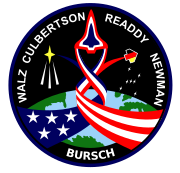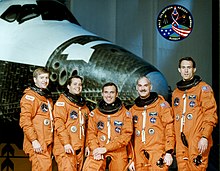Our website is made possible by displaying online advertisements to our visitors.
Please consider supporting us by disabling your ad blocker.
STS-51
 IMAX photography of Discovery in orbit, viewed from the free-flying SPAS-ORFEUS astronomy platform | |
| Names | Space Transportation System-51 |
|---|---|
| Mission type | Advanced Communications Technology Satellite (ACTS) satellite deployment Astronomy |
| Operator | NASA |
| COSPAR ID | 1993-058A |
| SATCAT no. | 22795 |
| Mission duration | 9 days, 20 hours, 11 minutes, 6 seconds (achieved) |
| Distance travelled | 6,608,628 km (4,106,411 mi) |
| Orbits completed | 157 |
| Spacecraft properties | |
| Spacecraft | Space Shuttle Discovery |
| Landing mass | 92,371 kg (203,643 lb) |
| Payload mass | 18,947 kg (41,771 lb) |
| Crew | |
| Crew size | 5 |
| Members | |
| Start of mission | |
| Launch date | September 12, 1993, 11:45:00 UTC |
| Launch site | Kennedy, LC-39B |
| Contractor | Rockwell International |
| End of mission | |
| Landing date | September 22, 1993, 07:56:06 UTC |
| Landing site | Kennedy, SLF Runway 15 |
| Orbital parameters | |
| Reference system | Geocentric orbit |
| Regime | Low Earth orbit |
| Perigee altitude | 300 km (190 mi) |
| Apogee altitude | 308 km (191 mi) |
| Inclination | 28.45° |
| Period | 90.60 minutes |
| Instruments | |
| |
 STS-51 mission patch  From left: Culbertson, Bursch, Walz, Readdy and Newman | |
STS-51 was a NASA Space Shuttle Discovery mission that launched the Advanced Communications Technology Satellite (ACTS) in September 1993. Discovery's 17th flight also featured the deployment and retrieval of the SPAS-ORFEUS satellite and its IMAX camera, which captured spectacular footage of Discovery in space. A spacewalk was also performed during the mission to evaluate tools and techniques for the STS-61 Hubble Space Telescope (HST) servicing mission later that year. STS-51 was the first shuttle mission to fly a Global Positioning System (GPS) receiver, a Trimble TANS Quadrex. It was mounted in an overhead window where limited field of view (FoV) and signal attenuation from the glass severely impacted receiver performance.[1] Full triple-redundant 3-string GPS would not happen until 14 years later with STS-118 in 2007.
- ^ "Analysis of the First Successful Flight of GPS Abroad the Space Shuttle". NAVAL POSTGRADUATE SCHOOL. Archived from the original on June 4, 2011. Retrieved November 17, 2009.
Previous Page Next Page


